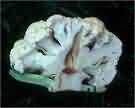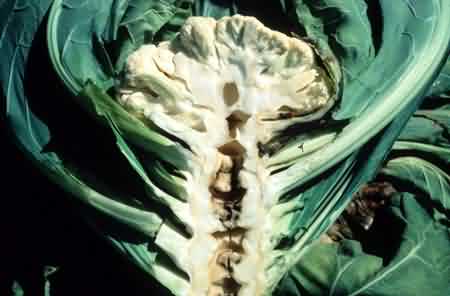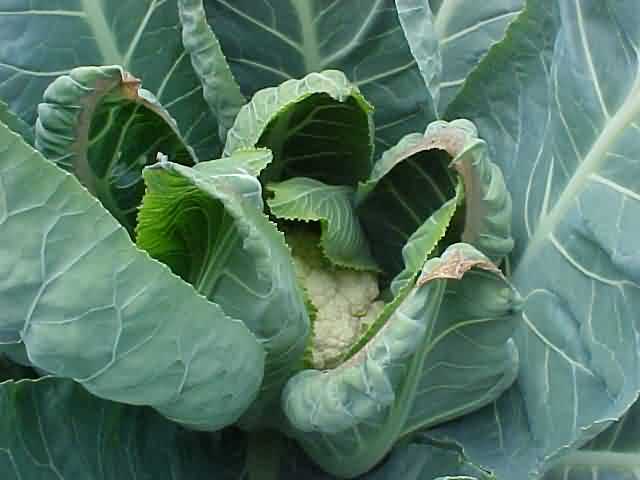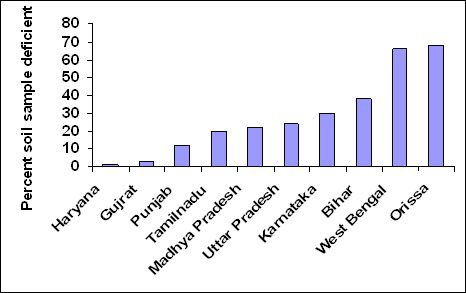भारत की मृदा व फसलों में बोरोन तथा मोलिब्डेनम की कमी और उर्वरकों के प्रयोग सेे उनमे सुुुुधार
Plants require eight micronutrients for their growth and development. Out of them, Boron (B) and Molybdenum (Mo) are anionic micronutrients found to be deficient in Indian soils and crops. The essentiality of the B and Mo for higher plants was first established by K. Warington in 1923 and by D. I. Arnon and P. R. Stout in 1939 respectively.
The information regarding deficiency of B and Mo in soils in India, their role in plant growth and deficiency symptoms and fertilizers containing B and Mo for amelioration is being provided for the benefit of the stakeholders.
Role of Boron and Molybdenum in plant growth and their deficiency symptoms
Normal boron sufficient plants are having B content ranging from 10 to 200 mg/kg. Boron is neither a constituent of enzymes nor it activates any of the enzymes. Most important property of B is to form stable complexes with organic compounds. It is responsible for the cell wall formation and stabilization, lignification and xylem differentiation. It imparts drought tolerance to the crops. It plays a role in pollen germination and pollen tube growth.
It facilitates ion uptake by way of increasing the activities of plasma membrane bound H+-ATPase. It facilitates transport of K in guard cells as well as stomatal opening. Plants having B concentrations of the order of 5 to 30 mg/kg are suspected to be B deficient. In annual crops, the symptoms of boron deficiency vary from one species to another.
Black gram deficient in boron does not show any visible symptoms in the seed, but the yield may fall by as much as 50%. In peanut or soybean, boron deficiency often results in an empty space within the seed, known as "hollow heart". A common result of boron deficiency in all crops is an interruption in flowering and fruiting. Yields are poor, and the fruit or grain is deformed or discolored. Boron deficiency symptoms become conspicuous on the terminal buds or the youngest leaves.
Internodes become shorter and give appearance of a bushy or a rosette appearance. B deficiency of different crops are known as heart rot of sugar beet and marigold, browning or hollow stem of cauliflower, top sickness of tobacco and internal cork of apple. B deficiency symptoms of sunflower, papaya, cauliflower and broccoli are given below (Plate 1).


Sunflower Papaya


Cauliflower Broccoli
Plate 1. B deficiency symptoms of different crops
Mo in plants is needed for various physiological functions. A healthy Mo-sufficient plant contains 0.1 to 2.0 mg/kg of Mo. Mo plays important biochemical role in plants because it exists as Mo (VI) under oxidative environments in plant system and undergoes reduction to Mo (V) and Mo (IV) forms. It catalyzes biological nitrogen fixation (BNF) being a component of nitrogenase enzyme.
It enhances nitrate reductase activity (NRA). Mo is involved in protein biosynthesis. It also affects the formation and viability of pollens and development of anthers. Plants having less than 0.1 mg/kg of Mo are regarded as Mo deficient. Mo deficiency resembles the N deficiency.
In plants with reticulate venation, the earlier effects of Mo deficiency appear as chlorotic mottling between the veins on old or middle leaves all over the surface. Mo deficiency in cauliflower is termed as whip-tail disease (Plate 2).


Plate 2. Mo deficiency symptoms in cauliflower
Deficiency of Boron and Molybdenum in soils of India
B is the only non-metal among the micronutrients and it occurs in low concentrations in the earth’s crust. Sedimentary rocks contain more B than igneous rocks. Major sources of B in soil are minerals like Borax (Na2 B4 O7 .10H2 O), Kernite (Na2B4O7.4H2O), Colemanite (Ca2B6O11.5H2O), Tourmaline [Na(Mg,Fe)3,Al(BO3)3Si6O18 (OH)4], Ulexite(NaCaB5O9 .8H2O), Kotoite[Mg3 (BO3)2]. Plant uptake forms of B available in soil solutions are H3 BO3, H2 BO3-, HBO3 2-, BO33-. Soils developed from acid eruptic rocks, Utisols, and coarse textured Entisols are poor in available B. B deficiency in soils of different states of India varies widely (Figure 1) and on average about 33 per cent soils of India are categorized as B deficient.

Figure 1. Extent of B deficiency in different states of India
Mo is the least abundant micronutrients in the lithosphere. It has also been reported that about 49 % soils in Andhra Pradesh (from analysis of 240 soil samples from Srikakulam and Vizaynagaram districts), 10% soils in Gujarat, 28% soils in Haryana, 18% soils in Madhya Pradesh are Mo deficient. On an average 13 per cent soils of India are deficient in Mo.
Mo deficiency usually occurs on plants grown on well drained acidic soils and in soils originated from parent materials low in Mo content. In soils, Mo gets fixed in iron and aluminum compounds as well as on silicates at low pH. Peaty, alkaline and poorly drained soils commonly have high Mo content. In poorly drained soils, formation of soluble ferrous molybdates or molybdites may lead to high Mo availability to plants. Molybdenum in soil solution occurs predominantly as MoO42-, HMoO4- and H2MoO4. Concentration of MoO42- and HMoO4- increases dramatically with increasing soil pH. Above pH 4.0, MoO42- is major dominant species.
Extremely low concentrations of molybdenum are maintained in the soil solution. Mo is taken up by plants as molybdate ions (MoO4-2). Various factors affecting its availability in soil include soil pH and liming, reaction with Fe and Al, interaction with other nutrients, soil texture, climatic effects and plant factors. Mo is the only micronutrient whose availability normally increases with increase in soil pH.
Mo has particular attraction to aluminum & iron oxides and humic acid in the pH range of 3.5-8.0. the adsorption capacity of humic acid is high at pH range of 3.5-4.0. Major forms of Mo found in soil are sulphides, oxides and molybdates. Mo containing minerals like molybdenite (MoS2), ilsemannite (Mo3O8.8H2O), wulfenite (PbMoO4), ferrimolybdite [(Fe(MoO4)3.8H2O] and powellite (CaMoO4) etc. exist in soil. Primary source of Mo in weathering zone is molybdenite.
Amelioration of B and Mo deficiency through fertilization
Different B containing fertilizers have been tested for their efficiency and effectiveness for managing B deficiency in soil. Borax is more commonly used through soil application for correcting B deficiency in various crops. Boric acid, solubor, colemanite, and B-frits etc. are other sources of B (Table 1).
Diversified crop responses have been recorded to application of B @ 0.5 to 2.5 B /ha in B deficient soils. Soil plus foliar application of B results in higher crop response as compared to either soil or foliar application.
Mo deficiency can be corrected by soil and foliar applications or by seed treatments. Since the availability of Mo increases as soil pH increases, liming of acid soils to pH 6.5 to 7.0 will frequently prevent or correct Mo deficiencies. The application of 0.01 to 0.5 kg Mo ha-1 will generally correct Mo deficiency.
Foliar applications of Mo have usually been more effective than soil applications for crops grown under dry conditions. Sodium molybdate and ammonium molybdate are most commonly used due to their solubility in water and easy availability (Table 1).
Molybdenum containing fertilizers can be applied as seed treatment, foliar spray or soil application. During application of Rhizobium inoculant to legumes, Mo fertilizer can be applied.
Table 1. List of B and Mo containing materials used for correcting their deficiencies
|
S. No. |
Compound/material |
Chemical formula |
Element content (%) |
|
Boron |
|||
|
1. |
Boric acid |
H3BO3 |
17 |
|
2. |
Borax |
Na2B4O7.10H2O |
10.5 |
|
3. |
Solubor |
Na2B8O13.4H2O |
20 |
|
4. |
Colemanite |
CaB6O11.5H2O |
10 |
|
5. |
Boron Frits |
Fritted glass |
2-6 |
|
6. |
Sodum pentaborate |
Na2B10O16.10H2O |
18 |
|
7. |
Granubor II |
Na2B4O7.5H2O |
15 |
|
Molybdenum |
|||
|
1. |
Sodium molybdate |
Na2MoO4. 2H2O |
39 |
|
2. |
Ammonium molybdate |
(NH4)6Mo7O24.4H2O |
52 |
|
3. |
Mo trioxide |
MoO3 |
66 |
|
4. |
Molybdic acid |
H2MoO4.H2O |
53 |
|
5. |
Mo frits |
Fritted glass |
0.1-0.4 |
Authors:
S. K. Behera1, A. K. Shukla2 and B. L Lakaria3
1 Senior Scientist, Directorate of Oil Palm Research, Pedavegi, West Godavari, Andhra Pradesh-534 450
2Project Coordinator , AICRP (Micronutrients), 3Principal Scientist, Indian Institute of Soil Science, Nabibagh, Berasia Road, Bhopal – 462 038
Email:
